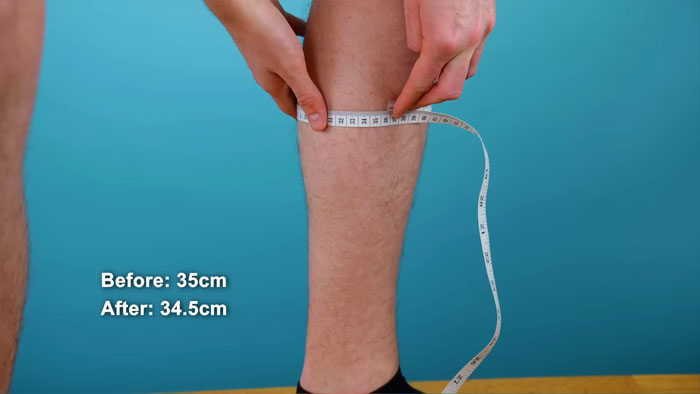Walking is often praised as one of the easiest, most accessible forms of exercise. It’s low-impact, gentle on the body, and something almost anyone can do. But is it really as effortless as it seems?
That’s the question YouTuber Jack Massey Walsh set out to answer when he attempted to walk 250,000 steps in just seven days, averaging nearly 36,000 steps, or 17 miles, every single day.
At first, Jack was confident he could handle the challenge. But it didn’t take long for him to realize it was far tougher than he imagined. Still, he pushed through, and what he discovered about his body in the process was genuinely surprising. Keep reading to see how the week-long experiment transformed him.
Jack Massey Walsh set out to see what would happen if he walked 250,000 steps in just one week

Image credits: Tamar Willoughby (not the actual photo)
What he discovered along the way truly surprised him

Image credits: JackSucksAtLife

Image credits: JackSucksAtLife
“Putting one step in front of the other is no easy task at all”

Image credits: JackSucksAtLife
The challenge Welsh set for himself has already racked up over 3 million views, and it’s easy to see why. Walking around 36,000 steps a day for seven days straight is no small feat. For comparison, that’s roughly seven times more than what the average American walks daily, which is about 5,000 steps.
Before starting, Welsh didn’t overhaul his routine. He made no major changes to his diet beyond eating a bit more protein, and he didn’t do any special physical preparation either. On day one, he was feeling confident.
“I am tired, but I am fine. It’s just one step in front of the other,” he said.
But that confidence quickly wore off. By day two, he admitted the strain was setting in.
“Putting one step in front of the other is no easy task at all,” he explained. “Literally every single step hurts and is a chore.”
Things only got harder from there. By day five, the pain in his feet was so bad he needed a painkiller just to keep going, showing viewers how they were covered in blister pads. On day six, he pushed through a swollen ankle, and shortly after finishing the challenge, he even developed a black toenail.
Clearly, walking isn’t for the weak.

Image credits: JackSucksAtLife

Image credits: JackSucksAtLife
One of the most unexpected parts of the challenge was the difference it made to his body

Image credits: JackSucksAtLife
What shocked Welsh most wasn’t the pain, but the physical changes he saw—results he never expected from walking alone. Before starting, he weighed himself and measured the circumference of his torso, arms, legs, and chest so he could track progress.
By the end of the week, he had lost 0.9 kg (2 lbs), 1 cm on his arms, 3.5 cm on his waist, 0.5 cm on his calves, and 2 cm on his chest. Surprisingly, he also gained 0.5 cm on his thighs.
Reflecting on the experience, Welsh described it as “an amazing feeling of accomplishment” when he finally counted down those last few steps to reach 250,000.
“I wasn’t expecting to be able to see any difference, so this is really surprising,” he said.
Still, he cautioned others not to repeat his extreme approach.
“Do I recommend walking 250,000 steps in a week? Absolutely not.”
“Do I recommend doing somewhere between 8,000 and 20,000 steps per day, depending on your personal circumstances? Absolutely,” he concluded.

Image credits: JackSucksAtLife

Image credits: JackSucksAtLife

Image credits: JackSucksAtLife

Image credits: JackSucksAtLife

Image credits: JackSucksAtLife

Image credits: JackSucksAtLife

Image credits: JackSucksAtLife
Watch the full video below
So, how many steps is enough?
Naturally, Welsh’s challenge raises the question: how many steps do we actually need each day to stay healthy?
You’ve probably heard of the “10,000 steps a day” rule. But here’s the twist: that number didn’t come from science, the British Heart Foundation reveals. It actually started as a marketing slogan for a pedometer launched during the 1964 Olympics in Japan. The company chose it because the Japanese character for 10,000 (万) looks like a person walking.
Despite its origins, the idea stuck, and researchers have since studied it extensively. Many studies link 10,000 steps a day to lower risks of dementia, cancer, and heart disease, as well as mental health benefits.
But the most comprehensive research so far, published in the European Journal of Preventive Cardiology, reviewed 17 studies involving over 200,000 people. It found that health benefits began with far fewer steps:
For people over 60, the biggest benefits appeared between 6,000–10,000 steps a day, while for younger adults, it was between 7,000–13,000. Beyond those ranges, the benefits leveled off.
The bottom line is: there’s no one-size-fits-all number. Everyone’s body and lifestyle are different, and what matters most is doing what’s sustainable for you. If 10,000 steps feels out of reach, start smaller, even just 1,000 more than you’re currently doing makes a difference.
And remember: going overboard can be just as harmful as doing nothing at all. The goal isn’t to push yourself to the breaking point, but to find a balance that feels good and keeps you moving.
Welsh’s effort left many commenters impressed and even inspired



















 Follow Us
Follow Us





